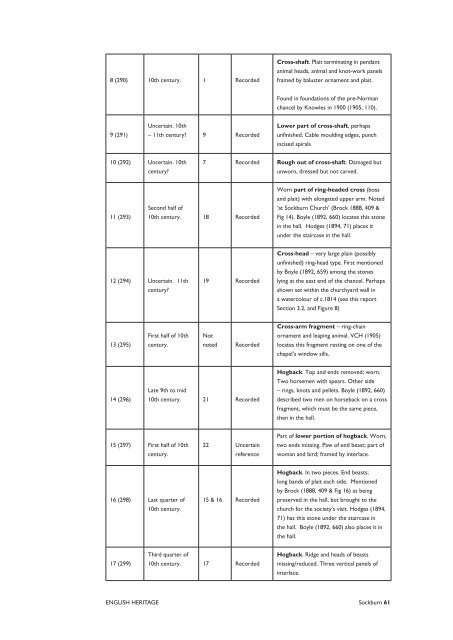Sockburn Hall, Darlington: an archaeological ... - English Heritage
Sockburn Hall, Darlington: an archaeological ... - English Heritage
Sockburn Hall, Darlington: an archaeological ... - English Heritage
You also want an ePaper? Increase the reach of your titles
YUMPU automatically turns print PDFs into web optimized ePapers that Google loves.
8 (290) 10th century. 1 Recorded<br />
9 (291)<br />
Uncertain. 10th<br />
– 11th century? 9 Recorded<br />
10 (292) Uncertain. 10th<br />
11 (293)<br />
century?<br />
Second half of<br />
Cross-shaft. Plait terminating in pend<strong>an</strong>t<br />
<strong>an</strong>imal heads, <strong>an</strong>imal <strong>an</strong>d knot-work p<strong>an</strong>els<br />
framed by baluster ornament <strong>an</strong>d plait.<br />
Found in foundations of the pre-Norm<strong>an</strong><br />
ch<strong>an</strong>cel by Knowles in 1900 (1905, 110).<br />
Lower part of cross-shaft, perhaps<br />
unfinished. Cable moulding edges, punch<br />
incised spirals<br />
7 Recorded Rough out of cross-shaft. Damaged but<br />
10th century. 18 Recorded<br />
12 (294) Uncertain. 11th<br />
13 (295)<br />
14 (296)<br />
century?<br />
First half of 10th<br />
century.<br />
Late 9th to mid<br />
19 Recorded<br />
Not<br />
noted Recorded<br />
10th century. 21 Recorded<br />
15 (297) First half of 10th<br />
century.<br />
16 (298) Last quarter of<br />
17 (299)<br />
10th century.<br />
Third quarter of<br />
22 Uncertain<br />
reference<br />
15 & 16 Recorded<br />
10th century. 17 Recorded<br />
unworn, dressed but not carved.<br />
Worn part of ring-headed cross (boss<br />
<strong>an</strong>d plait) with elongated upper arm. Noted<br />
‘at <strong>Sockburn</strong> Church’ (Brock 1888, 409 &<br />
Fig 14). Boyle (1892, 660) locates this stone<br />
in the hall. Hodges (1894, 71) places it<br />
under the staircase in the hall.<br />
Cross-head – very large plain (possibly<br />
unfinished) ring-head type. First mentioned<br />
by Boyle (1892, 659) among the stones<br />
lying at the east end of the ch<strong>an</strong>cel. Perhaps<br />
shown set within the churchyard wall in<br />
a watercolour of c.1814 (see this report<br />
Section 3.2, <strong>an</strong>d Figure 8)<br />
Cross-arm fragment – ring-chain<br />
ornament <strong>an</strong>d leaping <strong>an</strong>imal. VCH (1905)<br />
locates this fragment resting on one of the<br />
chapel’s window sills.<br />
Hogback. Top <strong>an</strong>d ends removed; worn.<br />
Two horsemen with spears. Other side<br />
– rings, knots <strong>an</strong>d pellets. Boyle (1892, 660)<br />
described two men on horseback on a cross<br />
fragment, which must be the same piece,<br />
then in the hall.<br />
Part of lower portion of hogback. Worn,<br />
two ends missing. Paw of end beast; part of<br />
wom<strong>an</strong> <strong>an</strong>d bird; framed by interlace.<br />
Hogback. In two pieces. End beasts;<br />
long b<strong>an</strong>ds of plait each side. Mentioned<br />
by Brock (1888, 409 & Fig 16) as being<br />
preserved in the hall, but brought to the<br />
church for the society’s visit. Hodges (1894,<br />
71) has this stone under the staircase in<br />
the hall. Boyle (1892, 660) also places it in<br />
the hall.<br />
Hogback. Ridge <strong>an</strong>d heads of beasts<br />
missing/reduced. Three vertical p<strong>an</strong>els of<br />
interlace.<br />
ENGLISH HERITAGE <strong>Sockburn</strong>

















